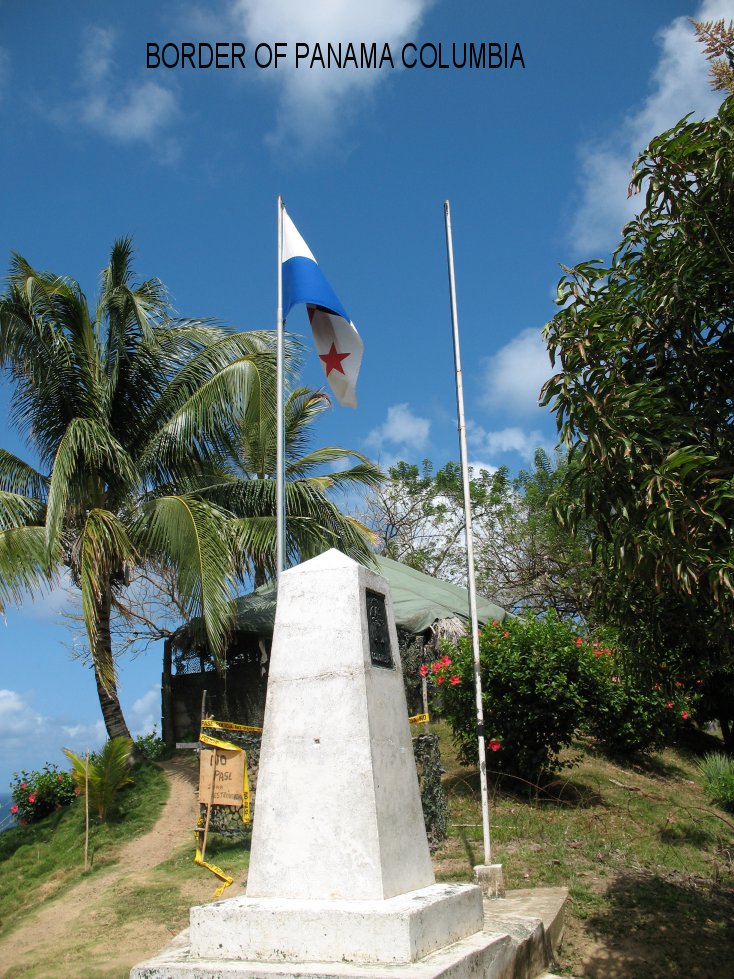

ARRIVING SAN BLAS ISLANDS TO PANAMA FROM ZAPZURRO COLUMBIA
This Page describes our Panama stay 2008
to 2009 up until our departure for Honduras and Guatemala.
Scroll down this page for our initial cruising year
spent in Panama including the San Blas Islands. In order to
skip down the page to view our return from Canada back to
Panama follow the link displayed here-
RETURN TO
PANAMA IN THE FALL 2008
Next morning, February 4th 2008, Kuna Yala haled. Beating our way into NNE winds we sailed over the border into the San Blas Islands. The sun only peeks out occasionally now. Mountains cascade down to the sea in misty moisty panoramas. The Darien range disappears into the clouds.
Approaching Carreta, our first indigenous community, was quite an experience. Fortunately we had done some homework and I knew a few Kuna words from our invaluable Eric Bauhaus guide. The whole community was interested in Tundra. All were eager to hang on the rails and peer at her finery.
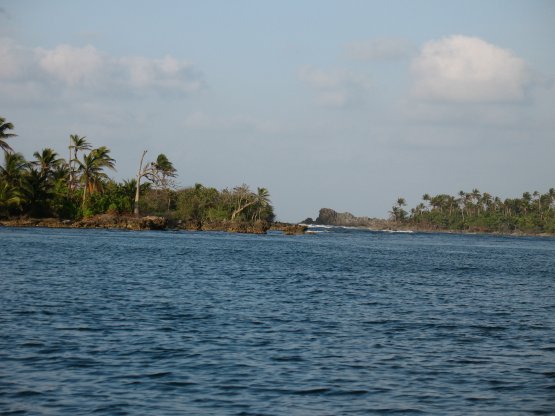
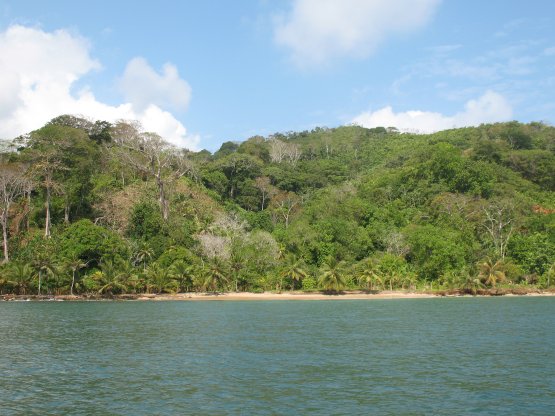
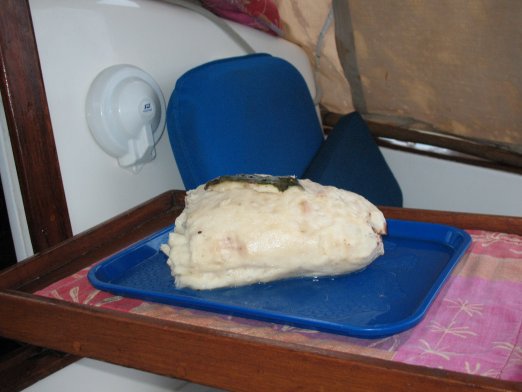
The secretario, Joseph came out with his assistant, Patricio and delivered an anchoring fee of $10.00. They sold us a large soursop for $1.00, which we weren't sure we wanted. It would mature in 4 days. OK. Four days later you can see how soursop looks, It proved to be a delicious treat. Also we were issued an invitation to visit the village at 0900 manana. After an afternoon of exchanging pleasantries and fending off people of all ages, we slept soundly in anticipation of our visit ashore. Paddling into the beach was easy. Walking to the village was interesting along the shore.
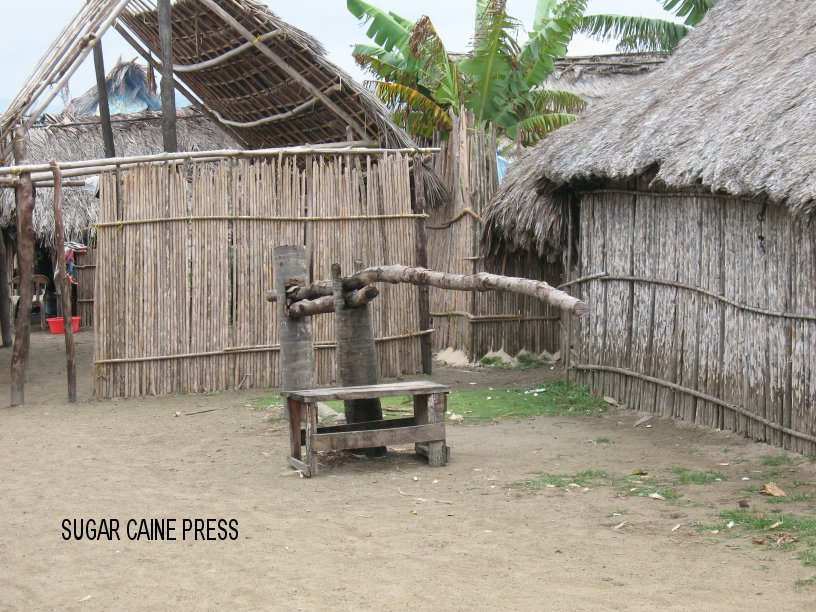 En route we
observed their crude mechanism for extracting juice and goodness
from sugarcane, talked to several families and their cacique
(superior of the village). Most of them asked for chocolate and
coffee.The village was a maze of cane pole huts with thatched
roofs. We proceeded to ask directions to the secretario's house.
Young boys eventually took us to their machete-wielding mothers
who immediately told us to vamos. Retreat we did! We must have
looked pretty threatening coming through their gate. It's quite
probable that they didn't realize that we were invited. This was
our first intro to the culture.
En route we
observed their crude mechanism for extracting juice and goodness
from sugarcane, talked to several families and their cacique
(superior of the village). Most of them asked for chocolate and
coffee.The village was a maze of cane pole huts with thatched
roofs. We proceeded to ask directions to the secretario's house.
Young boys eventually took us to their machete-wielding mothers
who immediately told us to vamos. Retreat we did! We must have
looked pretty threatening coming through their gate. It's quite
probable that they didn't realize that we were invited. This was
our first intro to the culture.
As a result we left quickly, giving the cacique and Elsia our gifts, hoisted the anchor and sailed on to Caledonia
.
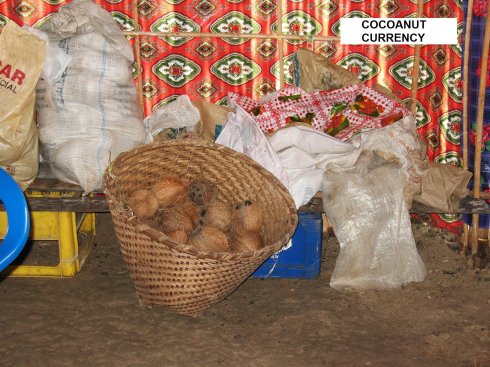
The Kuna culture is matrilineal. The women control the money and the men move in with them. Women call the shots! Traditionally the coconut trees belong to the women and that's how they trade with the Columbian trading boats that harmoniously ply the waters providing foodstuffs, fabrics, etc. Columbian traders collect coconuts in exchange for their myriad of wares. Kunas receive 15-20 cents per coconut. Coconuts are, to date, still their primary currency.
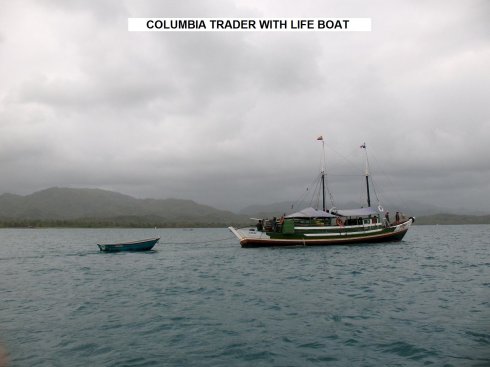
Most of the Columbiano traders are double-ended, have outboard rudders and noisy Detroit diesels. They run in all states of repair; some tow a dinghy, which we assume must be their life raft. They run in all weather, needle nosing the reefs. They amaze us as they ply the islands in all weather.
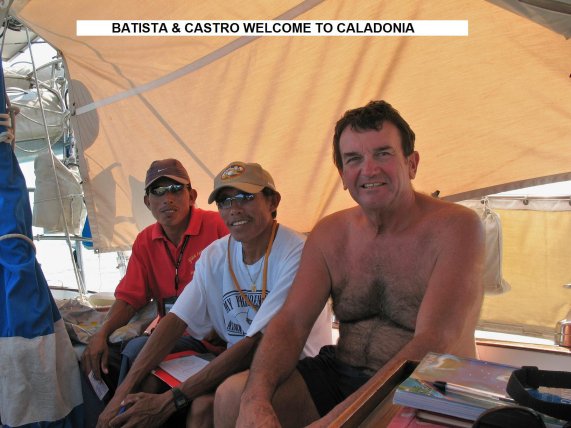
The 5th of February found us happily entertained by Castro and Batista, two young men who came on board with their official tourism badges from Caledonia. They charged us $10.00 plus a guide fee of $3.00 each and a dollar for our camera to visit their island. These young men were like sponges enthusiastically trying to learn English.
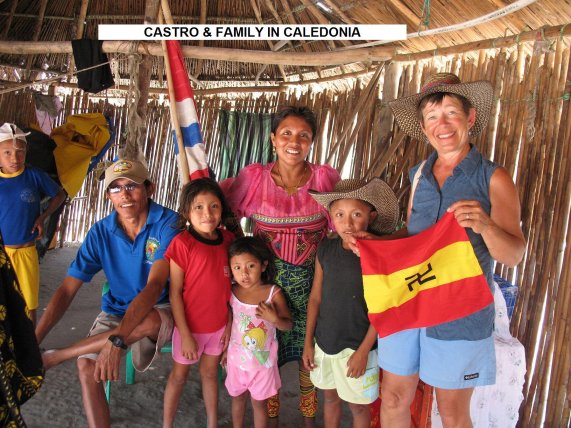
Castro enthusiastically invited us to visit his house and family. he and his wife were were definitely the chief entrepreneurs and promoters for Caledonia. Note the flag of the san Blas Islands properly referred to as Kuna Yela by by it's inhabitants. You might say it is a Swastica but in reality the emblem is backward and in no way does it have any concatenation to it.
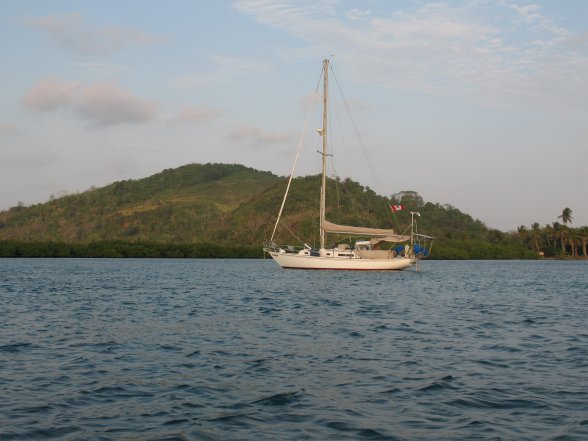
Our anchorage under Suledup Island was one of the prettiest yet, surrounded by reefs and remote from the village. The surrounding mangroves provide a perfect place for nasty little noseums to feast on us, thus we refrained from cockpit activity until the wind came up. Several ulus (dugout canoes) came by for a visit and showed us their contents. Some forage for firewood, some dive the reefs for langostinos, and others hoist their square cut sails and farm bananas, pineapple, yucca, and more on the mainland. They are amazing mariners and spend most of the daylight hours fending for family necessities.
The women make molas and sell them enthusiastically to anyone who happens along. Molas are an intricate layered form of reverse appliqué. Motifs depicted are colourful and based on happenings, animals, birds, flowers and forms surrounding their daily lives. They are hard to resist. I now have mola hatbands, belts, and you name it.The children are taught their trade and encouraged at a very early age. Their molas are some of my favourites. One included the alphabet. What a clever teacher!
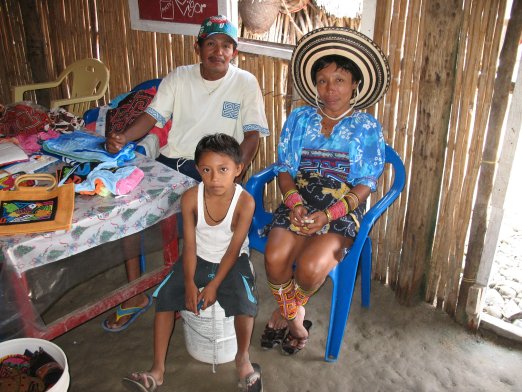
Dona Amelia and her husband, Atiliano, made lunch in their restaurant for us. Molas blossomed. Several stores stocked basic foodstuffs on Caledonia. We were able to get onions, and several tins of mixed vegetables. Kuna bread was a special treat. Today we ate our last banana.
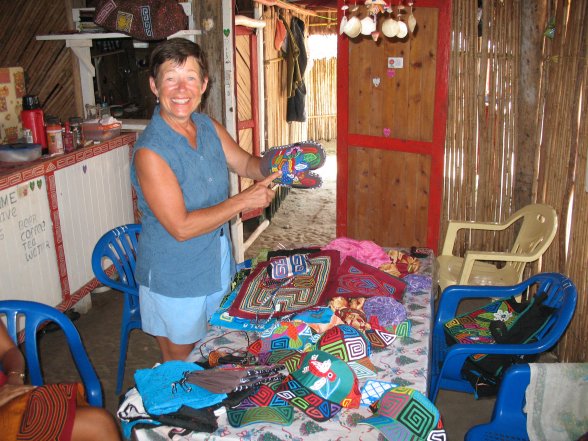
With our major mola purchases Atiliano gave us a regalo (gift)
of 3 platanos. I now use them in cookies and our morning
porridge. Also Castro's wife sewed us a Kuna rebellion flag for
$5.00 as noted in photo above. We are proudly flying it on our
courtesy halyard much to each village's delight.
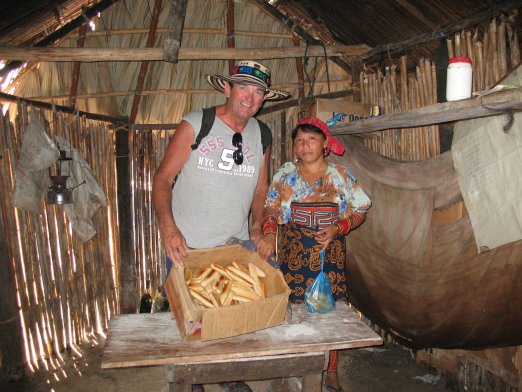
Brian also bought Kuna bread as we call it from the Bread Lady inside her house that also serves as the bakery. Note the small loaves as well as the size of a typical kuna woman as compared to Brian. The Kuna Indians are known as the second smallest race in the world.
Below Kathy poses with some of the energetic children of Caledonia. They were fascinated with our rubber dinghy
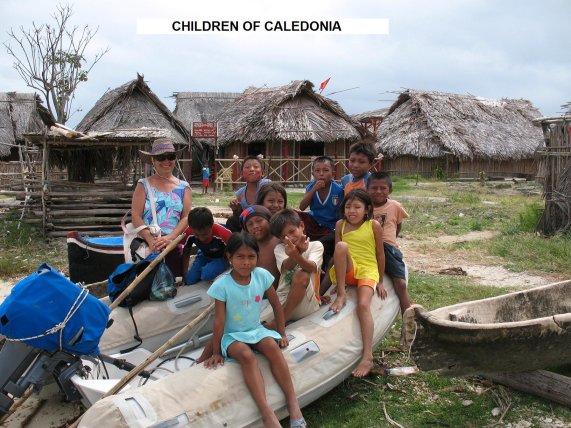

With sun up high in order to read the reefs, we headed NW to Isla Pinos on the 8th. Juarez came out next morning to collect their tax of $8.00 and promised bread and such. With good visibility and a late delivery ulu, we reluctantly forgot our goods and headed out through the reefs to Achutupu. Garbage in the water is a major hazard. Plastics of all description crowded the course. Barrels and a tree trunk were major hazards. One must keep a watchful eye at all times. Waves of 8 to 12 feet make for mighty uncomfortable beating into headwinds. Along the way we encounter Kuna sailors showing their remarkable sailing skills through the surf. Their rudder is their paddle and the keel is non existant yet we saw no capsizes.
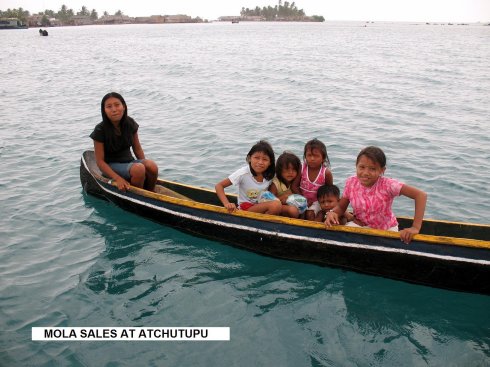
On our exhilarating sail we surfed between islands and
reefs and finally rounding into our Atchutupu anchorage
was pretty exciting. Anchoring under the village provided a
social event to say the least. Tundra's lovely gelcoat took a
beating as ulus with molas, ulus with shells, ulus with
congenial Kunas of all ages approached. Young men kindly paddled
over to the Columbian supply boat and retrieved platanos for us.
A Kuna resort is located on sland, so we went exploring
by dinghy for a change of pace. Fish lunch with
melon for dessert was a delicious treat. Upon leaving they sold
us 6 more oranges. Fruit is definitely in short supply. Opening
and eating our soursop was a gourmet experience. We did manage
to get some juice and ate every last piece for a lovely dessert.
It lasted 3 days. It overflowed with healthy seeds so we gave
them to our hosts each time they came to visit. They said they
would plant them. Sunday evening found us lulled by the
Congresso meeting ashore. Loud hallelujahs and much clapping and
singing accompany their services. A lovely treat. Our tax of
$5.00 was collected by a very shy Bremnan.
Among the Kuna Indians you will notice
occasionaly the presence of Albinos. Here we saw an albino child
and as you can imagine they are hard to miss in a mostly
coloured population
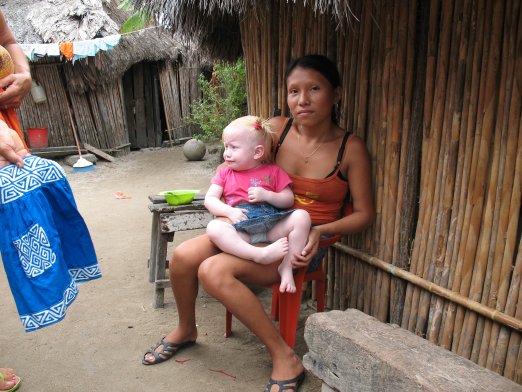
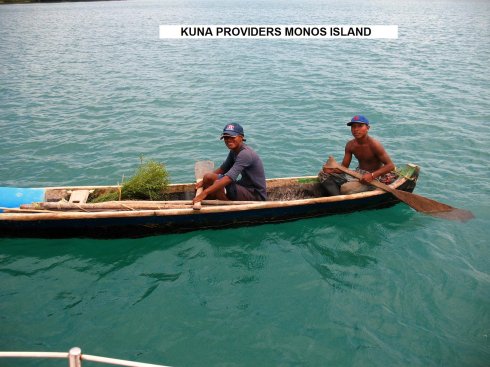
Thoroughly socialized we decided to move on to the remote quiet Monos Island anchorage on the mainland. Sharing two days of peace and quiet with the eagles, herons, and egrets with the occasional ulu visiting was blissful. En route to their mainland garden they would say hello. Later they showed us their catch. Some had a good mess of sardines. Others had iguana eggs.
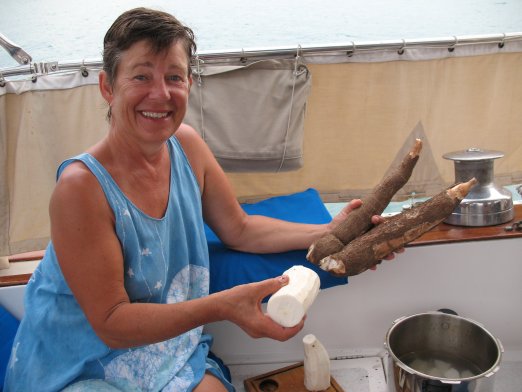
Upon return to their Tupile Island village one evening they gave us a regalo (present) of 3 yuccas. They are wonderful in sopa. We returned their kindness with Canada hats and eyeglasses for their women. Brian has picked up his guitar once more and evening singsongs are happy times as the sun sets. Battery operated headlamps and LED lights from Canadian Tire really help with our battery consumption in the evenings. Our Tupile Island hosts eventually came in a 37-foot Yamaha powered ulu to collect their $10.00 tax. Perhaps we're seeing more westernization creeping in.
Next morn with the sun high we wove our way through the reefs to Oroyo Point hoping for a good shot up to Snug Harbour. With winds whipping, we decided to retreat to Tupile Island. Anchoring just east of the village brought the usual curious ulus. The young boys wanted to practice their English and came back with 3 oranges for us. They loved their Canada hats, too. We dinghied in to the settlement to find nice wide streets of packed mud, several meagerly stocked stores and a green pineapple. Also the Columbian trader sold us potatoes and onions. The mola ladies got quite excited re our reading glasses. The Kuna race shuns marriage outside of their race and this produces an occasional albino. One blue-eyed fair skinned little girl as you can see above was quite a show stopper amongst them.
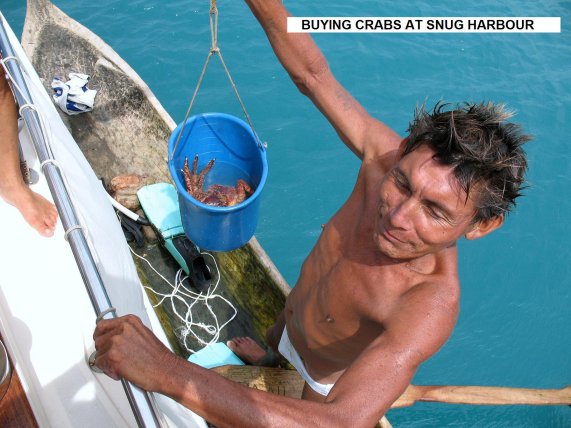
With good weather forecast Brian plotted our route into Snug
Harbour. Surprise! We found another boat. Snuggling up under an
outer reef inside the mangroves was quiet and peaceful. Ameliano
Delon arrived in his ulu to welcome us. After he and his
grandson Alberto sold us crabs they offered to get
vegetables, fruit, bread, chicken and all. It sounded wonderful.
He needed money up front, so off he went with our $10.00 and
promises to be back manana at 0800. He arrived with all and
great stories of his fiesta anoche. (last night) He giggled as
he recounted how they had eaten all our chicken breasts. I had
to laugh, too. Our chicken wings made a delicious sopa and
filled our tummies. The green bananas may ripen. The bread was
delicious. As we heard on the Panama net next morning, be
careful of giving money 'up front' in Playon Chico.
Other ulus sold us crab and langostinos very reasonably. The
saila collected his $10.00 promptly. It
was a lovely stay.
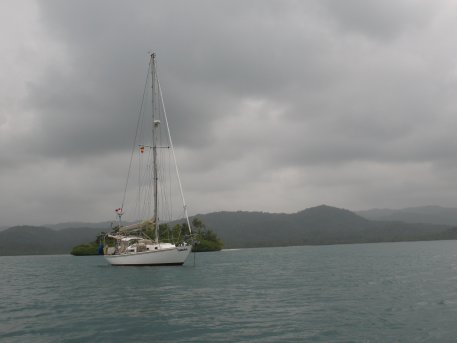
On February 17th 2008 we anchored off the tiny islet of Tigre. It was only $5.00 and $3.00 more each to tour the town. We declined and showered in fresh water. Their backyards typically house their pigs and toilets over the water. It appeared that we were in the Queen's latrine! Wakened to pouring rain-our first this trip- we filled up all our utility jugs. The sun broke through in time for us to haul anchor for Rio Diablo.
On shore we viewed the school bus (ie, ulu) doing it's duty
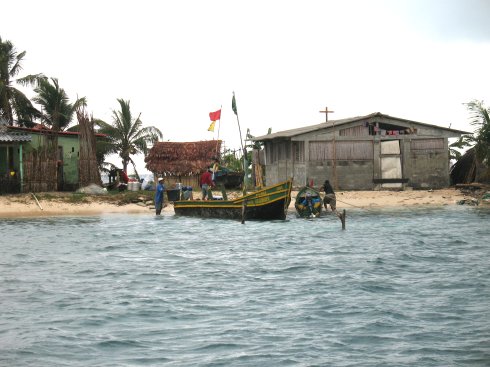
En route we checked out the now defunct Kuna Hotel on Iguana Island. It is one dilapidated thatched hut in an idealic setting between the reefs. At the approach to Rio Diablo several Columbian traders confirmed our route around the reefs. Nargana Island provides a secure anchorage protected from the trades. Noseums the first night confirmed this.
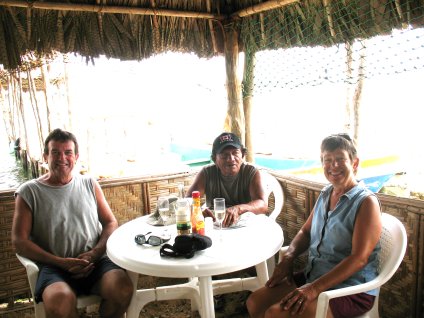
Frederico approached in his ulu to offer his services and became our constant companion on the island. Here you see us relaxing in the popular local restaurant on the Island
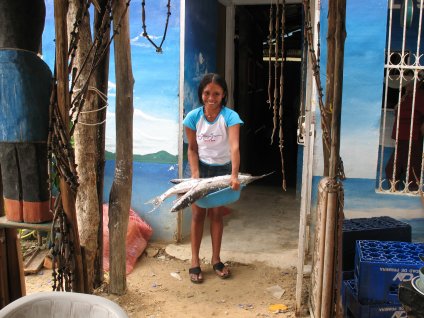
Lunch is brought in for us fresh off the dock as you can see on
the left freshly caught Barracuda.
Nargana is joined to Corezon de Jesus by a
substantial steel and concrete foot bridge which is under repair
for their grand rebellion celebration on March 8th. These two
villages have relinquished most traditional Kuna customs. Most
of the women are dressed in western mode. Solar public
telephones are available in the public square. Panama police are
present. We were able to get more green bananas, melon, a
watermelon, a papaya, tomatoes, cabbage and pear juice. What a
bonanza! One store had frozen chickens with the feet on. I asked
her if she would take off the feet and she got one off with
difficulty so Brian came to her aid. He broke it off with
his hands right in front of her. She jumped back in amazement
saying "Muy fuerte!" i.e. Very strong! Lots of giggling ensued.
Much later I was surprised to find the head still on. Brian came
to the rescue once more. We threw the head to the crabs. Next
time I'll keep it for the fishing rod.There is a busy airline
schedule here and ready availability for flights to Panama.
Frederico even showed us a Kuna hotel he could get a room for
us. Muy noseums!
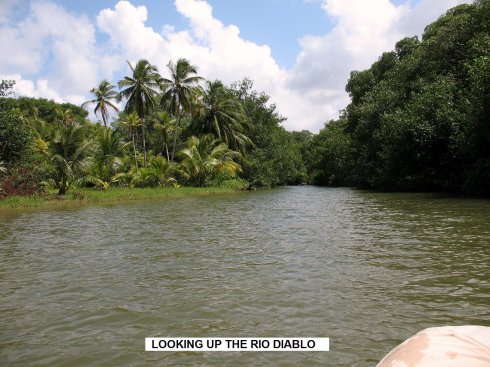
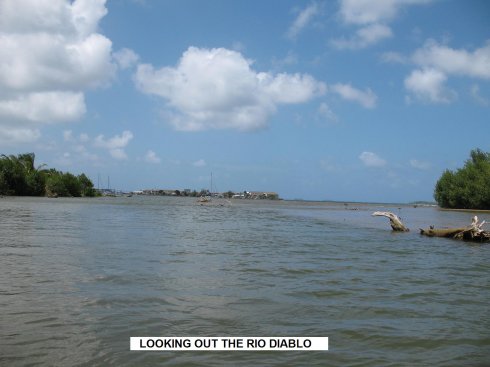
We couldn't leave without a trip up the river. Shallows at the entrance were 1 ½ to 2 feet and necessitated some poling to get in the channel. Once inside bird life was prolific. Farms along the side of the river were producing coconut, cocoa, plantains, bananas, and more. Butterflies and wildflowers were plentiful. Below you see a farmer's ulu parked along the side of the river as we pass by in our dinghy.
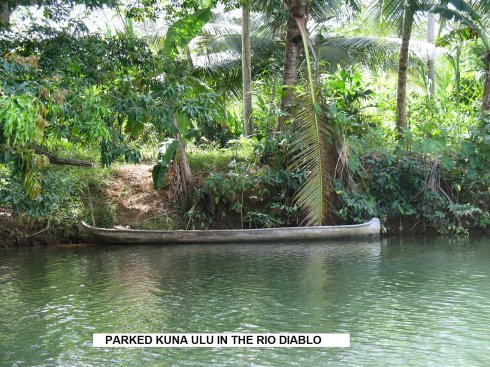
An ulu of little boys joined us and jumped in to swim with us in the clear, fresh water. They loved it when Brian swam out into the deep with them and proceeded to all soap up with us as well. Diving off the dinghy and under the dinghy was great sport. All squeaky clean they shanghaied a tow back out. Some of their teenage friends raced by us paddling. They showed us fruit and insisted that we traipse through leaf cutting ants to watch them climb. It was a very enjoyable happening.Koukla and several others arrived heading east so we shared times. They saw a caiman in the river on their trip.
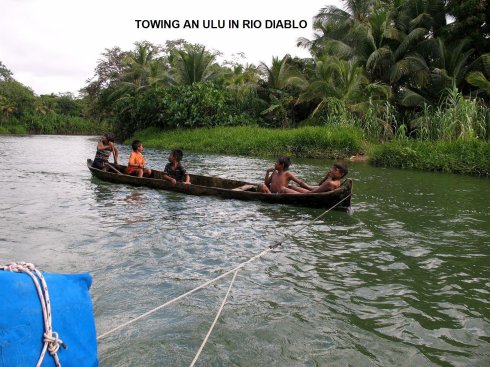
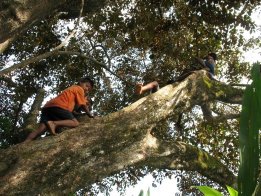
Today February 22nd 2008 we are anchored under Green Island with six others boats awaiting the arrival of Scrammin' from Porvenir. It is heavily overcast and a constant drizzle. This must be the Columbia low. An ulu arrived with a crab, langostinos, and lobster. All cost $5.00. Snorkeling promises to be good.
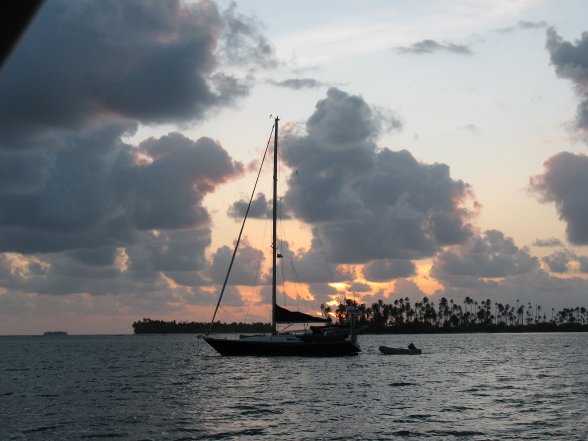
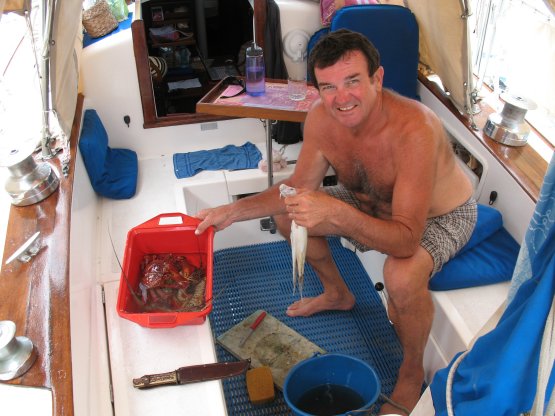
Yvonne and Tom on Scrammin’ and Yvonne’sister, Mary Jo sailed in on us at Green Island. Together we explored the islands of Coco Bandero and the Holandes Cays. Snorkeling, swimming, playing dominoes, identifying our many finds kept us happily occupied. Brian and I opted to stay in the “swimming pool”-a shallow, warm, great anchorage until our own relatives were due to arrive.
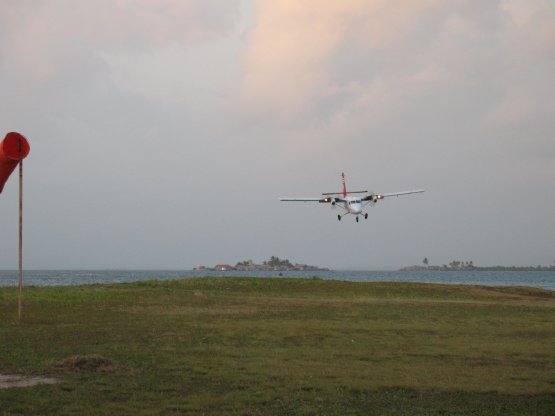 My brother,
Johnny and niece, Jeannie arrived from Vancouver for a couple of
weeks in March 2008. Their approach to Porvenir
in a small, 10-seater commuter plane was most exciting.
My brother,
Johnny and niece, Jeannie arrived from Vancouver for a couple of
weeks in March 2008. Their approach to Porvenir
in a small, 10-seater commuter plane was most exciting.
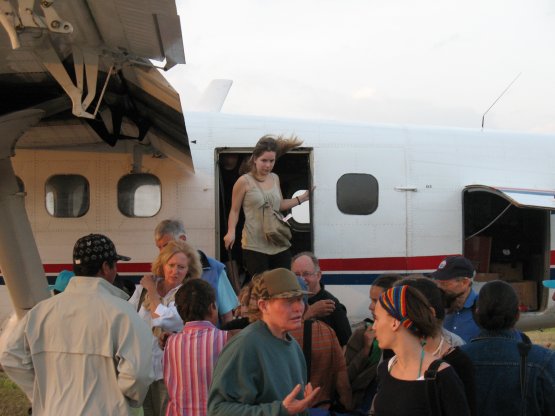
To the right you can just see Johnny's head behind the gentleman with the green cap in the forground.
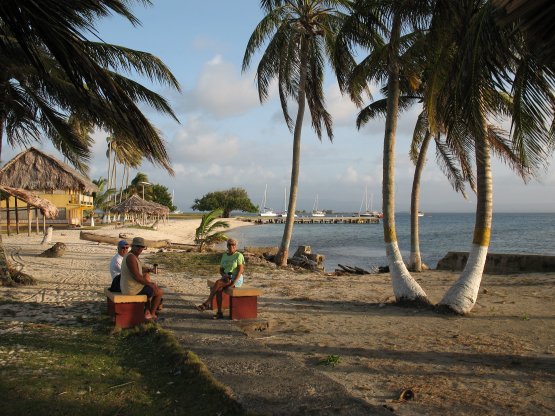 The island
of Porvenir is about a quarter of a mile in diameter with the
airstrip dividing the customs area from the restaurant-hotel
area. Tundra was carefully anchored off the runway approach and
we made mighty sure to stand a good distance from the strip
during approach and departure. On the left the anchorage off the
runway is on the other side of the dock. What a welcome sight
they were!
The island
of Porvenir is about a quarter of a mile in diameter with the
airstrip dividing the customs area from the restaurant-hotel
area. Tundra was carefully anchored off the runway approach and
we made mighty sure to stand a good distance from the strip
during approach and departure. On the left the anchorage off the
runway is on the other side of the dock. What a welcome sight
they were!
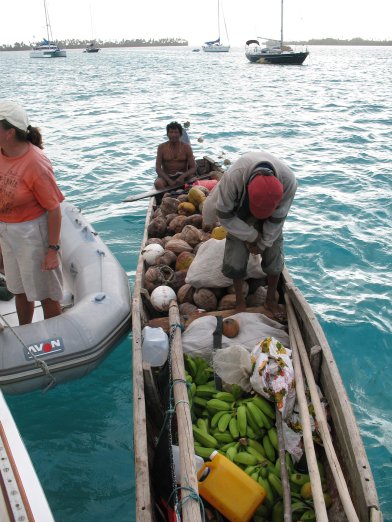
With everyone comfortably unpacked and stowed on
board, our first expedition was a dinghy ride to Wicha Huala to
tour the island. Buying a few provisions and touring the white
cane huts made for a good culture intro. On the right we
provision with one off the very few supply boats that cater
to the cruisers.
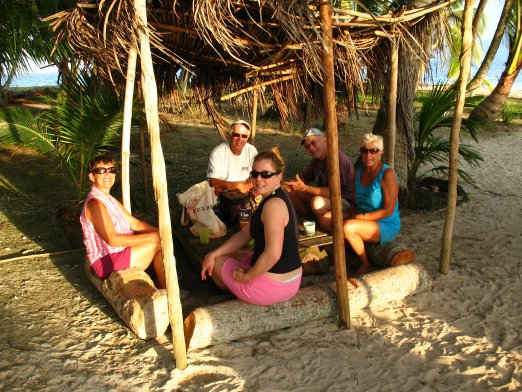
For our next adventure we sailed eastward inshore
of the Limones Islands closer to the mainland. While anchored
under the Naguarandup Cays we found a small
nurse shark – our first, and lots of beautiful shells ashore.
Light winds were merciful on our eager new crew. Snorkel
sightings included giant spotted ray, lobster (out of season),
few fishes and lots of glorious sun. Sunscreen is a must and
lots of water to keep all hydrated. Helping Sandy on Gambit
celebrate her birthday added a shore side element to the fun.
Sundowners ashore with the yachting community exposed us all to
more interesting individuals. Flags of all nationalities are
found here.
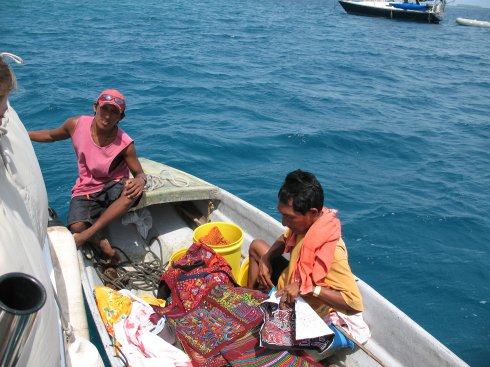
Sailing on to Nargana and Corezon de Jesus to
show J and J the big towns, (maybe 100 citizens) provided
another provisioning stop, too. From Nargana west, more western
culture was evident. Greatly appreciated fruits and veggies and
eggs arrived in sporadic ulu visits from Carti, on the mainland,
and Miramar, closer to Punta San Blas. Just this year a bumpy
dirt road was opened from Panama to Carti-the el llano to Carti
road. It is recommended to take it from west to east as there is
more downhill and one doesn’t have to get out and walk as often!
Also daily visits from our Kuna mola enthusiasts kept us picking
and choosing from their varied supplies. Being a lovely tall
blond, our Jeannie was a big hit with our Kuna friends,
particularly the youngsters. Several times we were treated to
their antics as they cart wheeled and played together on the
beaches.
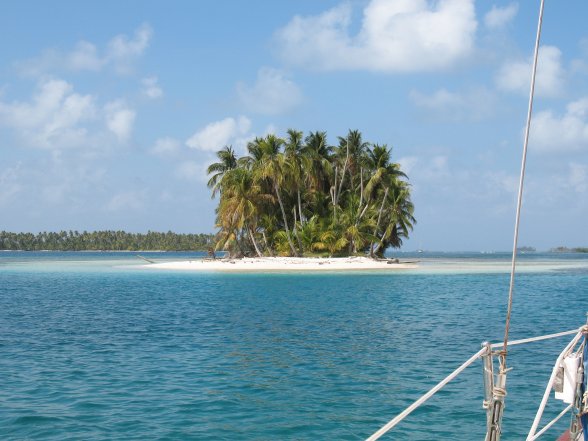
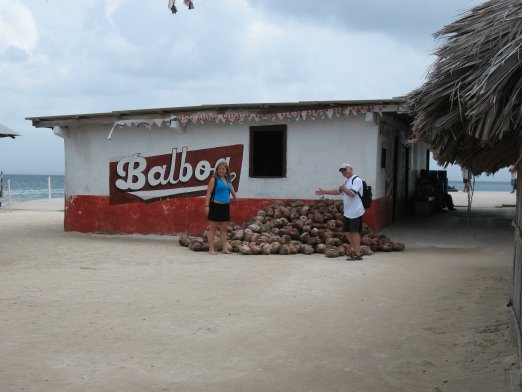
Dinghying up Rio Diablo had all
searching for caiman, but nary a one showed its head! We found
enough fresh water to bath in and wash some of our clothes. A
swim in fresh is always welcome. A lovely brisk wind sported us
across to Coco Bandero in time for lunch and a
spotted ray snorkel around one of the loveliest reefs in the
Caribbean. More dominoes ensued and Jeannie jogged around the
islet to all the cruisers delight. No one could keep up to her,
let alone, follow her cartwheels! Nice to have youth in our
midst! Sailing under the Banderos and across the Coabos Channel
was far enough for J and J. After anchoring securely in the
‘swimming pool’, water sports took over. The current was mighty
strong and deceiving here. The open ocean pours across a shallow
reef, over the swimming pool shallows and into deep on the lee
side. It really rips in a stiff breeze. Lovely barbecues and
parties on Barbecue Island kept us hopping and meeting new
friends. We helped Diane on Blow Me Away celebrate her birthday
with much merriment. Her sister had brought goodies including a
traditional piñata from Panama.
Moving west, around the corner, to the ‘hot tub’ provided new scenery. Mangroves behind and another great snorkel location. Running further west one finds the Limones and this completed our circuit with J and J. There is another opportunity to top up molas at the Porvenir hotel and restaurant.
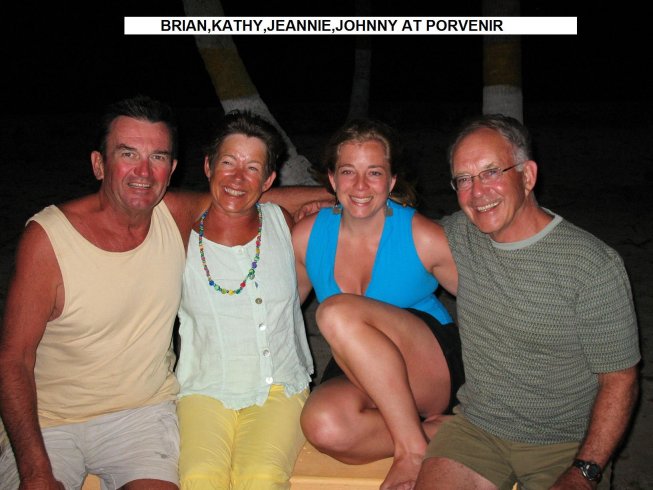
Here we enjoyed our finale domino tournament and dinner ashore.
J and J were ready at 0600 on the runway with tickets to ride
and many other hopefuls alongside. Fortunately they did manage
to get on the second plane. It is wise to stay overnight in Panama
City to give enough time for international
connections. Sadly we waved them out of sight into the sunrise.
Not to worry.
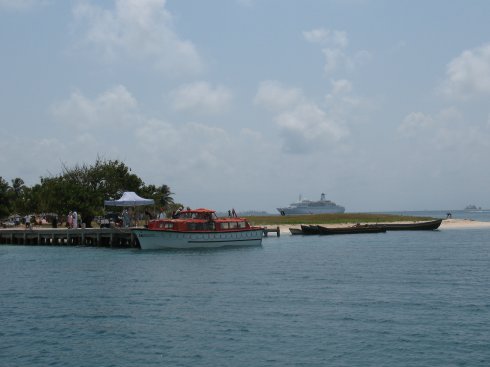
A cruise ship arrived so the little island of Porvenir took on another air. It was crammed with mola vendors from every surrounding island. Entertainment plus. Looking a little closer we realized that this ship was the original Love Boat After one more provisioning, we headed for the Limones to celebrate Easter with Scrammin.
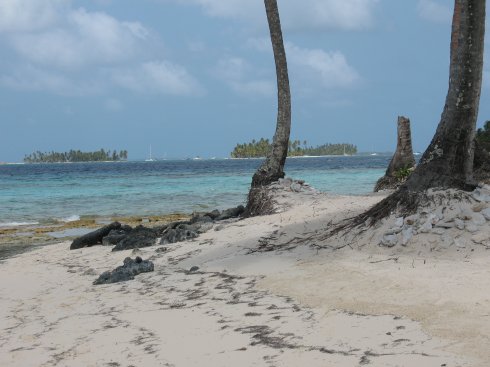
The winds were piping so the four of us happily read, played
ashore with Karen and Allen of Sylvia K and Larry (our
weatherman) and Susan of Moira. A Kuna from shore came out to
polish our stainless. He was eager to work, as his wife didn’t
do molas.
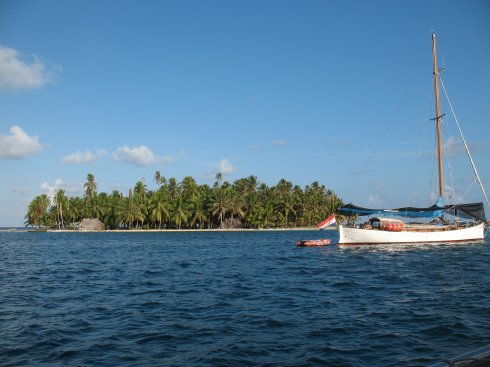
It was time to say goodbye for this year to Cumaca de (district) Kuna Yala – it’s autonomous, indigenous Kunas and their mythology, history, and rituals. Approximately 924 square miles with 400 islands of which 40,000 Kunas inhabit only 40 of the islands. Kuna territory also encompasses a mountain strip of mostly virgin forest on the mainland of Darien Province. Their basic foodstuffs are bland and basic and they are suffering over fishing. Don’t be surprised to see their garbage and sewage all in the water. Primitive mores are still in existence.At Chichime we chatted with and bought molas from a family leaving their island of coconuts and basic shelters via ulu, to return to Cidra on the mainland. They tend and farm their most beautiful islands sporadically. It was the end of March and the time had come to move on to the Canal.So Isla Chichime was our last anchorage before heading around the western boundary of Kuna Yala at Punta San Blas, threading through the Escribano Shoals to Isla Grande on the Panamanian coast. A shallow entrance to Miramar was inshore as we sailed by and we marveled at how the supply boats came from such a distance to provide for we yachties. Apparently there is a road in from Panama, so provisions are more plentiful.
Isla Grande had a pleasant hike to the lighthouse. People were very friendly and helpful. Apparently it explodes with Panamanian populace on the weekends and is unbelievably loud. One Bob Marley bar was wildly colourful.
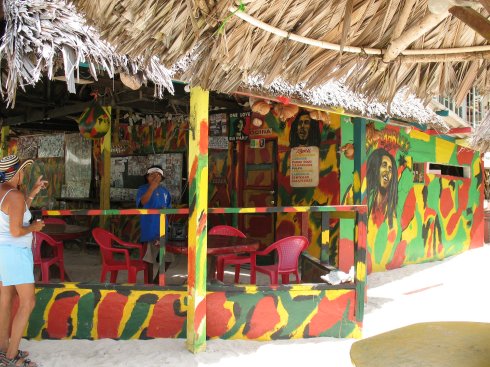
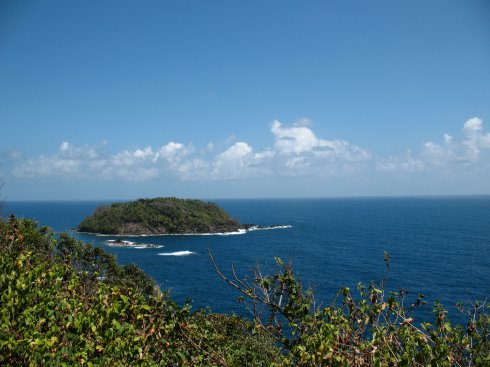
Puerto Linton is a deserted island except for a few howler monkeys that love to be fed, but watch your fingers. They are indeed wild and noted for being vicious. In tandem with Scrammin’ we took a dinghy tour to Panamarina and viewed the anchored boats stored behind a grandiose mangrove. There is a great little French restaurant as well. Be sure to check hours before going and navigate the mangroves in daylight, as they are reef strewn.
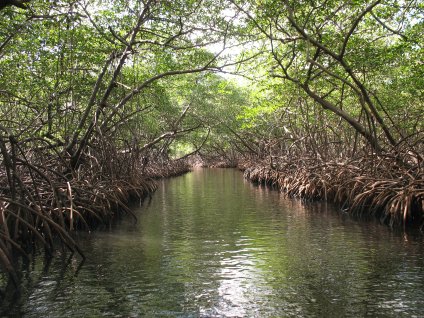
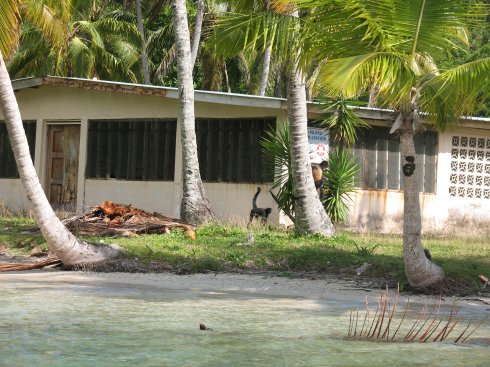
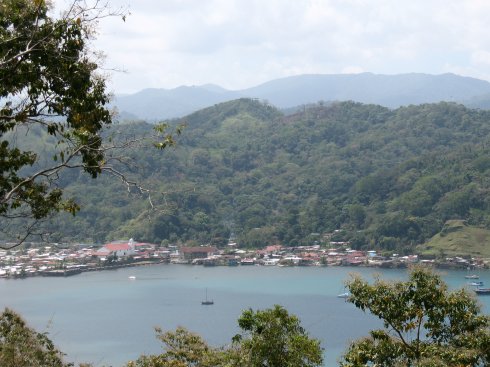
Another short sail had us anchoring in Portobello
shortly after noon. It is a well-protected harbour,
which is home to many ancient ruins. Much of the Inca gold was
stored here and in Fuerte San Lorenzo, Rio Chagres, en route to
Europe. The forts were pillaged by the Welsh buccaneer, Henry
Morgan in the 1600’s and by British Edward Vernon in the 1700’s.
UNESCO declared the ruins world heritage sites in 1980. Dining
in Portobello was a real treat at Drakes in the middle of town.
We also enjoyed ‘take-out’ street fried chicken.
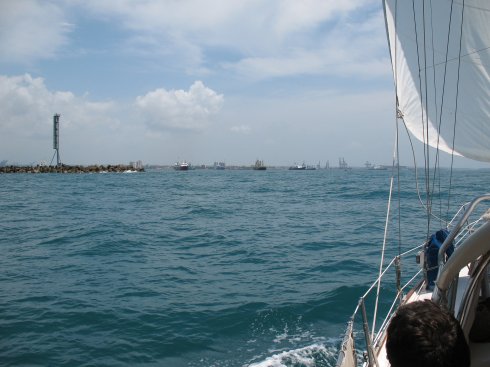
Our next destination was Colon. One enters
through the Panama Canal breakwaters only
after checking in with Port Control. It is an amazingly busy
harbour with watercraft of all descriptions. Most are big and
bound for the Canal. The flats are the only legal anchoring spot
in the area with very poor holding. Boats are continually
dragging. Panama Yacht Club and Shelter Bay Marina
provide dockage and are both welcoming. PYC is situated in
downtown Colon a short dinghy ride from the flats. Take a taxi,
as crime is rampant outside the gates.
Shelter Bay is located on the west entrance to the Canal at the previous US Fort Sherman site. It is a long bus ride across the Canal to shopping. Very often one must wait for the gates to open or close. Shelter Bay does run buses morning and afternoon. If you have lots of time, they’re great. Sometimes they’re unbelievably crowded. Taxies are available, too.
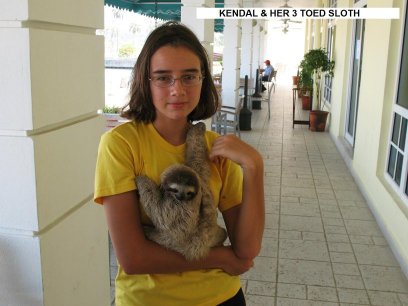
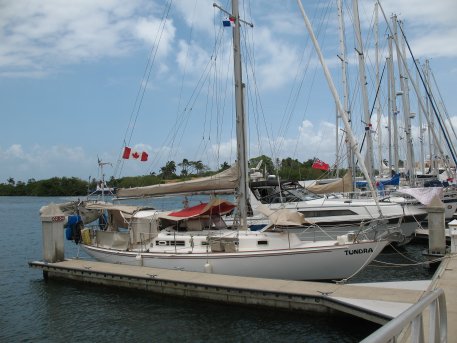
We really enjoyed the comforts here.While preparing for the yard we were fortunate enough to line handle on a German catamaran through the Canal. It is a great experience. One must use an advisor from the Canal staff plus 4 line handlers. By sailboat, an overnight is required in Gatun Lake, then on the next day to Panama City. We thoroughly enjoyed our transit and shopped for boat parts and canvas before riding the bus and taxi back to Shelter Bay.
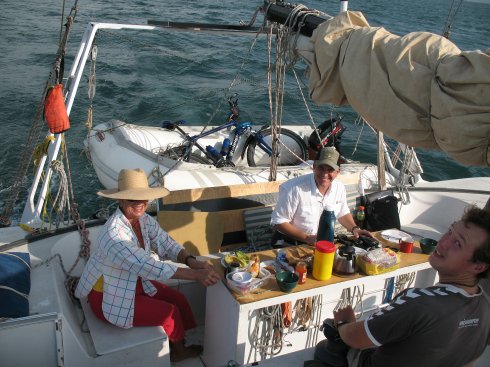
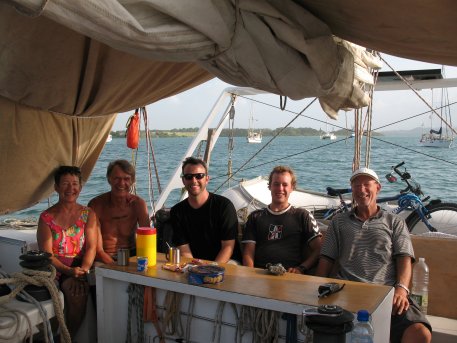
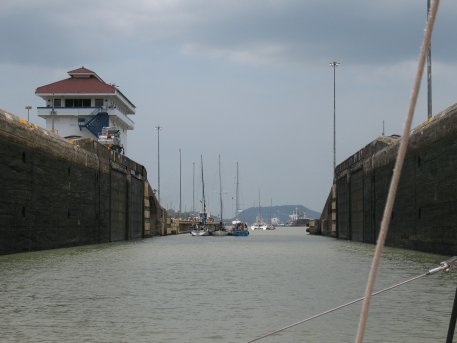
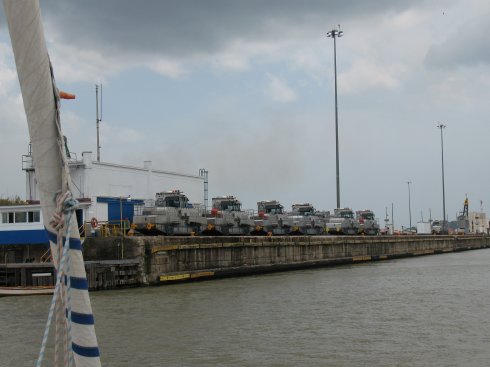
With a dock at our feet we did a lot of hiking in
the neighbouring jungle. Early or late was preferable to avoid
the mid day heat. Lots of animals called to us. Monkeys, sloths,
and coatis were regular sightings. A good paved road led to Fuerte
San Lorenzo and the Chagres River.
It was great hiking with overhanging trees some of the way.
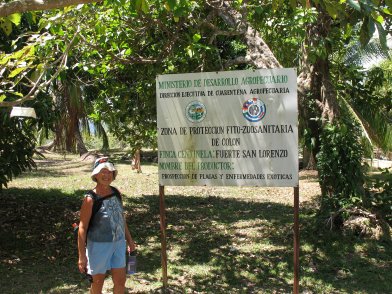
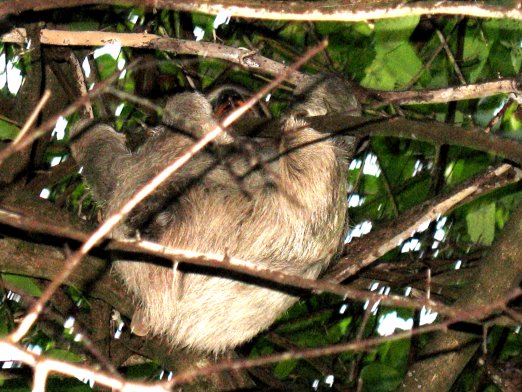
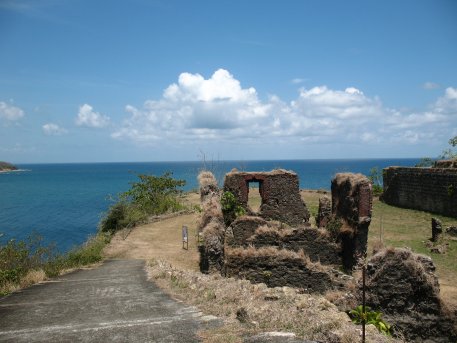
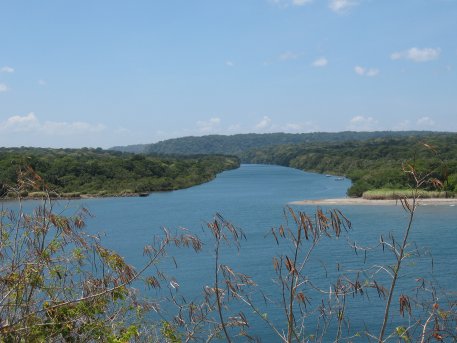
We hauled Tundra on April 30th and left for Panama City on the
2nd of May 2008. Several days touring Viejo Casco and shopping
was luxurious. La Costa Hotel was comfortable and had a birds
eye view of the city around a small rooftop pool area. We
enjoyed it very much.Tundra is sitting out of the water in the
Shelter Bay Yard in Panama awaiting our next great adventure.
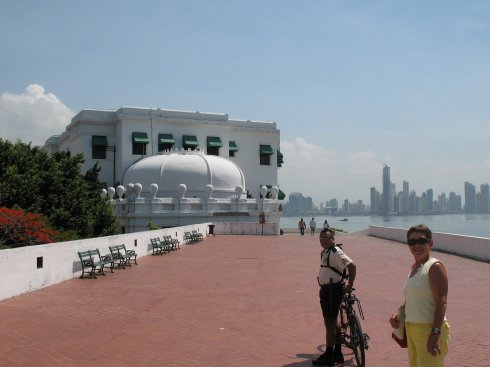
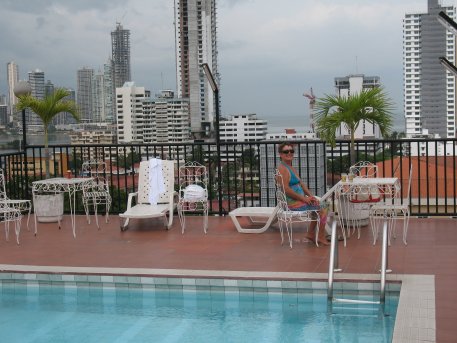
WE THEN RETURNED TO CANADA FOR THE SUMMER OF 2008
Home was most welcoming. We are enjoying
puttering, gardening, and relaxing in Sarnia warm temperatures.
A 2 week visit to BC was a ‘must’ for Grandma and yes, they have
all grown like weeds. Dad is still a going concern at 98 and
Aleta is well here in Ontario
On December 13th, 2008, a little later than usual, we made our way back to Tundra in Shelter Bay Marina and yard in Panama. Thanks to our Sarnia friend, Bob Eddy's periodic checks during our absence, she was in great shape. The dehumidifier did its job and our interior was immediately livable aboard. Naturally it took us a few days to organize gear and store in a few groceries. There is a marina bus driven by Victor that goes to the Quatro Altos shopping center daily during the week. The morning bus is free. The afternoon bus costs $4.00 each way. Victor is a wonderful driver. One ride back sported 43 passengers, one on the roof, plus groceries!
Inquiries re Shelter Bay can be directed to Lina, the marina secretary, who seems to singlehandedly manage business. Her email is <lina@shelterbaymarina.com and phone is 011 507 433 3581. www.shelterbaymarina.com is a web site to peruse.
While we were there Bruce and April on Chewbacca were an endless source of info. Bruce was replaced at New Years. Jesus 'Potter', whom, some of you will recognize from Bahia Redonda in Ve. is now dock master. The second Victor very capably ran the lifts and cranes and seemed to have a finger on the pulse of the yard. When our outboard wouldn't run, he suggested the magical cure-lots of WD 40 and a big wrench to free up the seized flywheel. He says they seize after 6 months storage here, regardless of conscientious care. He also glued Scrammins dinghy back together. The rainy season took its toll on equipment.The fridge didn't want to perform, so by trial and error, Brian traced the problem to a faulty module. Gratefully we temporarily borrowed one from Dick and Trisha on Geremar and had a new one brought in by Susan of Wooden Shoes crew, Tom. Yes, we depend on each other out here.
After scrubbing jungle grunge off all, scraping and painting the bottom, and polishing the hull, we launched on December 22nd. C-8 was our home dock over the holiday while we laid on the sails and scrubbed all royally. Xmas eve we organized a dock party to share a little eggnog and spin a few yarns with fellow cruisers. Nancy of Swan Song brought her table for hor's doeurves. With the addition of a tablecloth, we all had a merry time! On the 25th the cruisers under careful supervision of Yvonne on Scrammin and Bruce of Chewbacca, turned out a first class Xmas dinner in the restaurant with all participating. Dominoes was occasion for many laughs over the festive season with Miss Nancy's birthday providing a definite highlight.
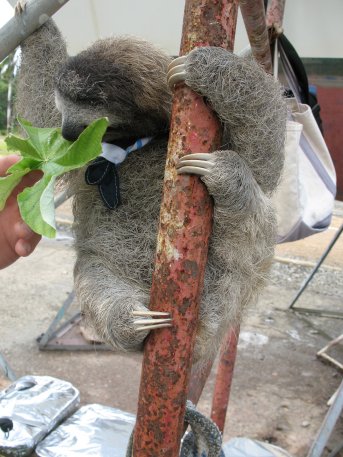
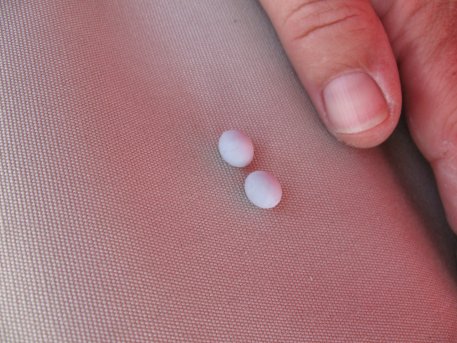
While we still had lots of fresh water the storage tarps got a good rinse. Repairs and sewing tested my trusty sewing machine. Our next sewing machine will be a 'tentmaker' with a walking foot. It was very highly recommended by April. The bimini needed new zippers. UV is a constant plague out here. The bilge sea cock fitting required some ingenuity. Brian replaced the old one with an epoxy special which he said would never let go again. Of course it was in the bottom of the stern lazerette. These challenges keep one alert and young! With some reservations re the state of our 5-6 year old house batteries, we headed off to La Casa de Batteria in Colon. Fortunately they had four 6 volt golf carts for us. A $25.00 delivery charge to the dock in the marina seemed like a deal. Our fridge loves the great voltage provided by the solar panels and wind generator now. Brian felt they were going gradually as it kept taking longer and longer to fully charge.
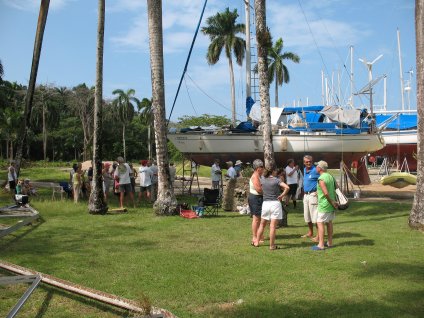
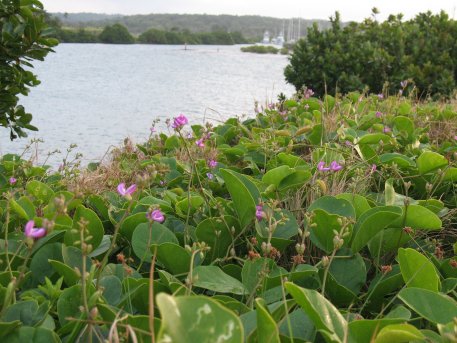
Shopping in the Colon area was easily accomplished. Colon 2000 is a cruise ship terminal where one can obtain computer necessities, gifts, groceries at the Super 99 and car rental. The Millennium mall has a Noveys which is a 2 story hardware store, plus a local food court which we enjoyed very much. Mega Depot is a short 1 mile taxi ride from Quatro Altos. It is a box store with large quantity items and provides a free delivery if one spends over $200.00. That isn't hard to do when provisioning. Watch the expiry dates. Also there is a kitchen store and another Super 99 grocery store in this plaza. We found old fashioned ginger snaps to die for here. Mid January we were finally ready to sail with a good weather window. Attempting to check out on our own proved fruitless. We highly recommend working through the marina staff. It cost about $20.00 and one doesn't have to deal with the bureaucracy. Bus driver Victor saves the day again.
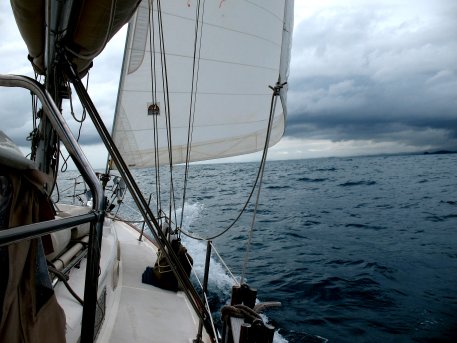 With a
bright early start on January 18th, 2009
Tundra pointed her bow for Linton. The main
provided some drive as we tacked back and forth close hauled to
the wind. Generally it was a bumpy, grumpy motor sail to the
northeast out between the Canal break walls and past Portobello.
The closer to Linton the rougher it got. Our
first overnight anchorage was a welcome break resting quietly
under Isla Linton. A zipping bristleworm joined us for our salt
swim. I wondered who was after it. Rainy weather persisted and
enough wind to realize that the wind generator needed some WD40,
too. Maintenance is always ongoing. A beautiful flowering almond
tree onshore makes me think spring is not far away.
With a
bright early start on January 18th, 2009
Tundra pointed her bow for Linton. The main
provided some drive as we tacked back and forth close hauled to
the wind. Generally it was a bumpy, grumpy motor sail to the
northeast out between the Canal break walls and past Portobello.
The closer to Linton the rougher it got. Our
first overnight anchorage was a welcome break resting quietly
under Isla Linton. A zipping bristleworm joined us for our salt
swim. I wondered who was after it. Rainy weather persisted and
enough wind to realize that the wind generator needed some WD40,
too. Maintenance is always ongoing. A beautiful flowering almond
tree onshore makes me think spring is not far away.
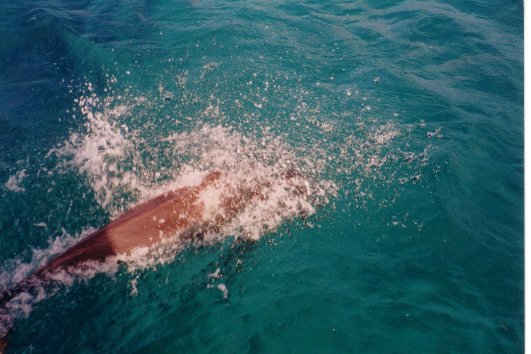
Dolphins joined us as we motor sailed out at dawn. Upon setting
our easterly course a great full sail developed. Squalls
presided most of the day sheltering us from direct sun. Winds
increased and shot us around Punta San Blas
and into our Isla Chichimee anchorage, south
of the island by 1600. It's good to be back in the San Blas. Our
VHF cruiser frequency is channel 72. Also we listen in to the
Turkey Net, the Mississauga Net, The Western Caribbean Cruisers
Net on 8107.0 at 0830, the Amateur Radio Breakfast Club Net on
7083.0 at 0800.
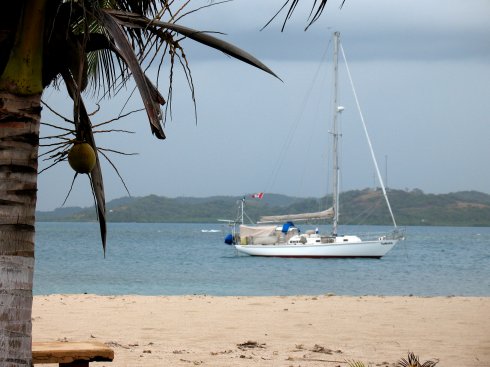
Checking in to Porvenir was a breeze except for having to change the alternator belt en route. We just sailed out until Brian was able to solve the dilemma. Sooty clean up is made easier with the help of baby wipes. Yes, baby wipes! They really help clean all the black away.
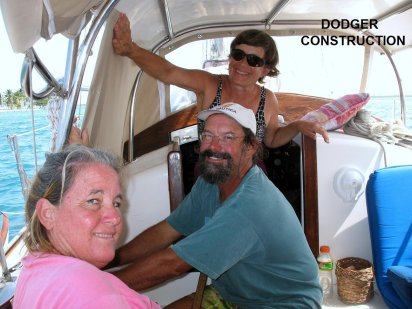
We have spent our time here with Bluesky so far. They sewed up a smart new dodger for us and we are very pleased with it. The West Lemon Cays are about 2 miles from Porvenir, so we have had lots of veggie boats through. They have a wonderful supply of veggies, pineapple, eggs and more. Also the fishermen offer us their catch 2 or 3 times a day. The mola ladies abound and life is good. Two days ago the Columbia low decided to settle in. We've had 20 to 30 knot winds consistently gusting to 40 in the squalls. Our little islands are awash with debris everywhere.
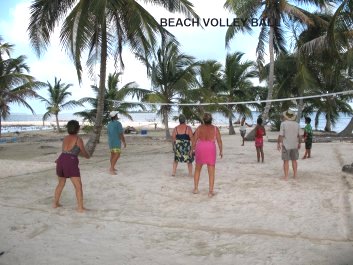 The
Kuna families here have been welcoming us ashore. They love
volleyball and are great players. Apparently, Albierto's family
are championship teams at their schools. I love to join them,
but am taking a brief hiatus as my hand decided to swell. Bocce
ball and dominoes still abound. We are expecting Todd and Sue
Wallace in Porvenir tomorrow. Hope the wind
abates soon.
The
Kuna families here have been welcoming us ashore. They love
volleyball and are great players. Apparently, Albierto's family
are championship teams at their schools. I love to join them,
but am taking a brief hiatus as my hand decided to swell. Bocce
ball and dominoes still abound. We are expecting Todd and Sue
Wallace in Porvenir tomorrow. Hope the wind
abates soon.
April 17, 2009
Five short days went by quickly with Todd and Sue
aboard. With lively winds, the snorkeling wasn't perfect. Other
activity kept us busy. Several master mola people visited and
showed us their beautiful handcraft. Daily visits from
our local BonPipi were entertaining too. She is an elderly Kuna
lady who paddles each day from her village in East
Lemmons in hopes of making a mola sale. Usually she
has the company of her grandchildren of various ages and appears
in all winds and weather. A brilliant full moon roast ashore was
great fun and an opportunity to gam with other cruisers while
watching the crabs foraging for our crumbs at the water's edge.
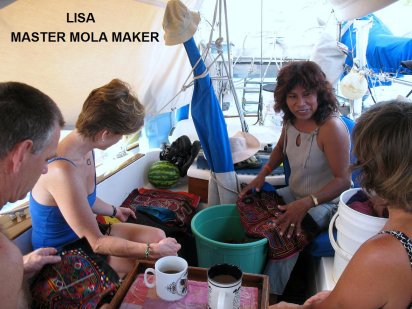
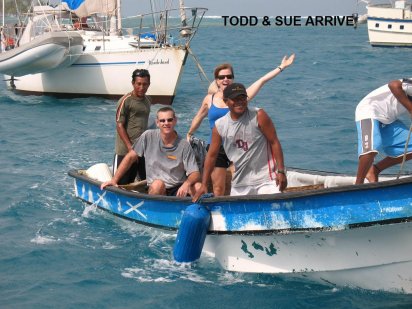
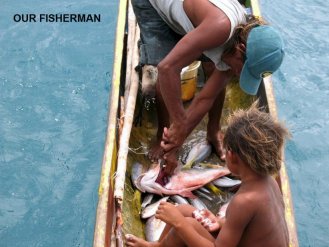
Our resident fishermen, Andrubin and his son Robalito, kept us
supplied each day with fish and crustaceans. It became a
challenge using the wonderful bounty from the sea in new
recipes. Tuna and snapper ceviche was a nice treat. Community in
the West Lemmons was interesting. Local residents got their
drinking and laundry water from one small cay providing daily
activity shoreside. Fishermen and families haul water, gather
wood and coconuts in a predictable rhythm. Our yachtie community
included Philanie, Scrammin', Allie Cat, Sawadi, Wonderland,
Sunrise, Bluesky and many more passing through.
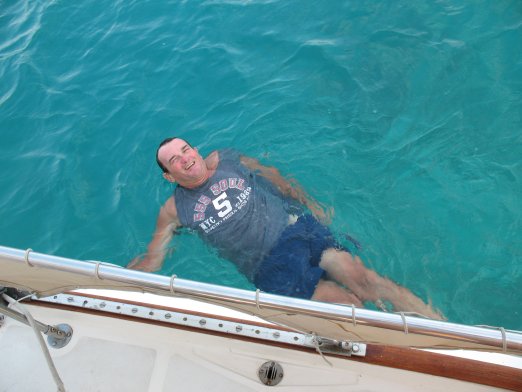
On February 14th 2009 we hauled anchor in tandem with Scrammin', moving a short distance to Salurdup in the Nagaraundup chain. Yvonne and I snorkeled and walked one of our favourite stretches of beach while Tom and Brian fended off the mola ladies. We spent several days sheltered from the strong trades at Canbombia Island en route to Nargana. So much so, that we discovered nasty little noseums on the beaches. Nabadup has a pretty snorkel off the east end. 'Dup` is island in Kuna language.
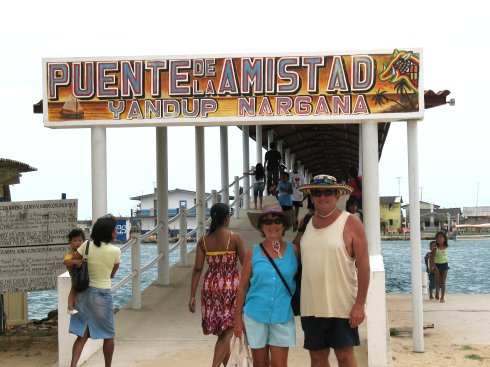
From Nargana Tom flew to Panama for his eye
treatment. Miraculously an injection has been discovered to
curtail and correct macular degeneration. Thankfully Tom is
doing very well again. Catching up with Jack on Stormbird, we
once more toured up the Rio Diablo. The river abounds with bird
life and fresh water is a wonderful delight for bathing. So much
so, that we repeated the trip the next day and washed our
clothes. That evening fishermen arrived alongside with a huge
spider crab. What a delicious sweet treat!
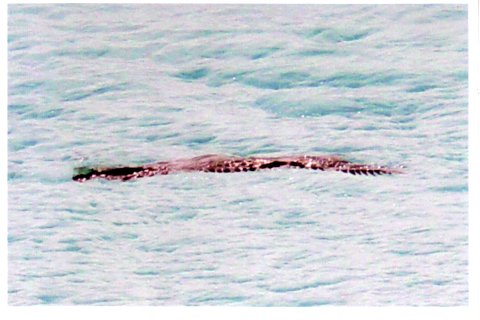
With Tom back aboard, off we went to Green Island,
just west of Nargana. Legend has it that there
is a resident caiman in the anchorage. (Caimans are
relatives of crocodiles) Not having seen one in our previous
visits, I must say, we were Doubting Thomases. But lo and
behold, about cocktail hour we got a call from Wet Bar that the
legend was putting on a show! How exciting! The performance
peaked our adventure buttons, but needless to say, we curtailed
our swimming activities. He or she must be harmless, as everyone
swims there and there are no reports of problems? Moving on, we
headed east again to Isla Tigre.
Each year on February 25th 2009, the residents re enact the Kuna rebellion against Panama in 1925. Along with a dozen other boats we were royally welcomed ashore to partake and view their celebration. Storytelling and acting the events out in vivid theatrical presentation depicted a pillaging of their culture and people. The children visibly absorbed the atrocity of their heritage.
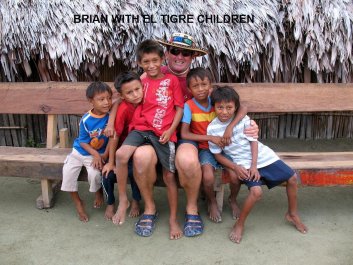
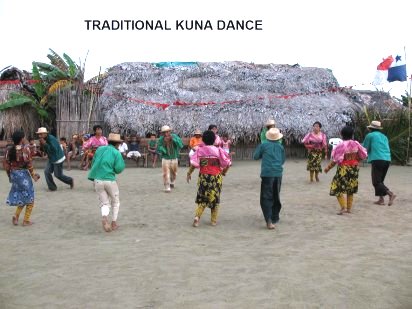
The Kuna nation is struggling to remain independent with the
elders determined to retain their customs and legends.
After serving us breakfast of cocoa tea and cheese on buns we
were encouraged to join them in a parade through the village.
Community activities were intergenerational until the
chicha event. As young Kuna women reach puberty, their rites of
passage are recognized and the adult community celebrates.
Ironically, the female honoured is not allowed to partake of the
ceremony. All the men and women of the village `whoop it up' in
grand fashion partaking of chicha-a fermented sugarcane drink,
much music and dancing. Of course we were invited to experience
this as well. After a short viewing we headed home for a
very pleasant gathering on Andromeda - including our Canadian
friends, Perequina, and Island Dream.
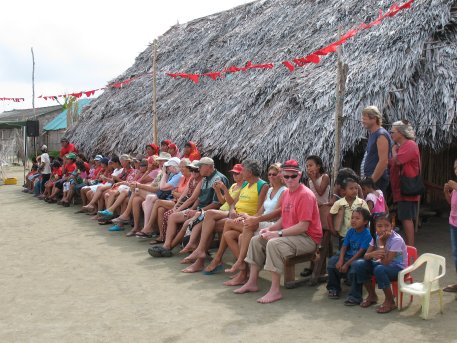
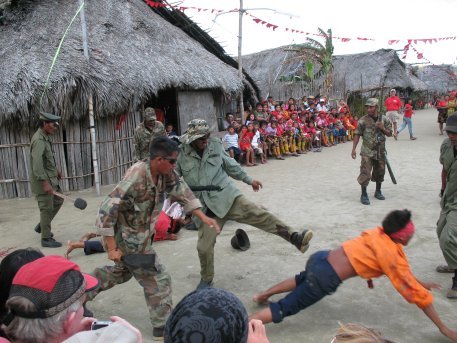
Making our way west again we relaxed under Miriadup for several days before anchoring in our favourite West Lemon haunt. Albierto and Angelina had invited we cruisers to their daughter's 5th birthday party. The food was wonderful including fishcakes, crab, lobster, potato salad and a huge birthday cake for all. Grandparents and all family prepared and partook. What a celebration on Elephant Island!
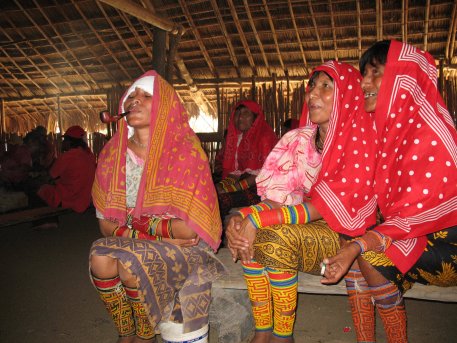
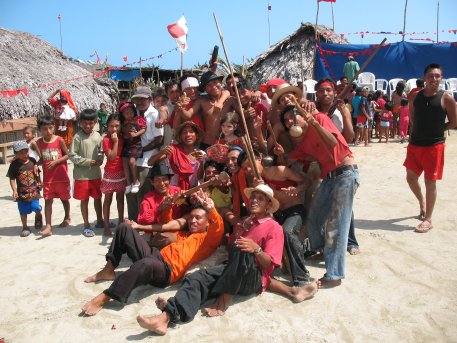
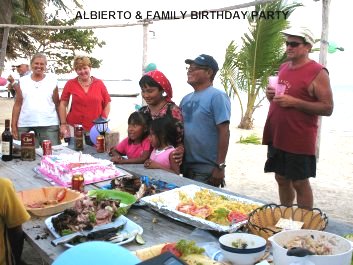
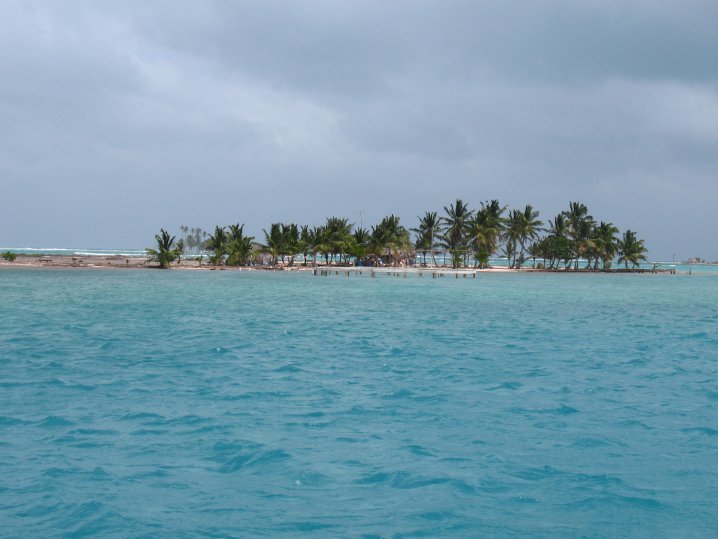
On March 3rd 2009 we checked out of Panama at Porvenir and then retreated to the West Lemmons to await a weather window to forge north further into the Western Caribbean enroute to the Rio Dolce Here we plan to store the boat for another hurricane season. We departed mid March heading to the Columbian Island of St Andres.
To follow Tundra's departure from Panama
and follow her sail enroute to Honduras and
Guatemala go to the next page please click here to take you to the page entitled
the
WEST CARIBBEAN
Updated Feb 20 2018